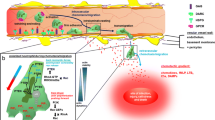Abstract
To clarify the mechanism of neutrophil infiltration in the liver of acetaminophen-induced hepatic injury, chemotactic factor released from hepatocytes exposed to acetaminophen has been investigated. Hepatocytes exposed to acetaminophen release nondialyzable chemotactic factor, although actaminophen in itself inhibits chemotaxis of neutrophils. Chemotactic activity of the nondialyzable chemotactic factor was reduced after treatment with heat (56°C, 30 min) or trypsin. Chemotactic activity was demonstrated at the molecular weights of around 25 and 55 kDa. Chemotactic activity of the conditioned medium was not significantly reduced in the presence of antibody against rat KC/gro protein (interleukin-8-related cytokine in rodent). Chemotactic activity of a 25-kDa factor was reduced by the antibody against KC/gro protein, but that of a 55-kDa factor was not reduced. Immunoblot analysis revealed that the peptide reacted with antibody against rat KC/gro protein was demonstrated at a molecular weight of around 20–25 kDa, but not at around 55kDa, when the conditioned medium of acetaminophen-treated hepatocytes was electrophoresed. These results suggest that hepatocytes exposed to acetaminophen release two types of chemotactic factors for neutrophils and that a major part of the chemotactic factor could be different from a member of interleukin-8 family.
Similar content being viewed by others
References
Zimmermann HJ: Effects of aspirin and acetaminophen on the liver. Arch Intern Med 141:333–342, 1981
Francavilla A, Makowka L, Polimeno L, Barone M, Demtris J, Prelich J, van Thiel DH, Starzel TE: A dog model for acetaminophen-induced fulminant hepatic failure. Gastroenterology 96:470–478, 1989
Kelly JH, Koussayer T, He D, Chong MG, Shang TA, Whinennand HH, Sussman N: An improve model of acetaminophen-induced fulminant hepatic failure in dogs. Hepatology 15:329–335, 1992
Michell JR, Snorri S, Thorgeirsson SS, Potter WZ, Jollow DJ, Keiser H: Acetaminophen-induced hepatic injury: Protective role of glutathione in man and rationale for therapy. Clin Pharmacol Ther 16:676–684, 1974
Lauterburg BH, Michell JR: Therapeutic doses of acetaminophen stimulate the turnover of cysteine and glutathione in man. J Hepatol 4:206–211, 1987
Lauterburg BH, Michell JR: Regulation of hepatic glutathione turnover in ratsin vivo and evidence for kinetic homogeneity of the hepatic glutathione pool. J Clin Invest 67:1415–1424, 1981
Lauterburg BH, Michell JR: Toxic doses of acetaminophen suppress hepatic glutathione synthesis in rats. Hepatology 2:8–12, 1982
Potter WZ, Davis DC, Mitchell JR: Acetaminophen induced hepatic necrosis. III. Cytochrome P450 mediated covalent bindingin vitro. J Pharmacol Exp Ther 187:203–210, 1973
Davis M, Harrison NG, Ideo G, Portmann B, Labadarios D, Williams R: Paracetamol metabolism in the rat: Relationship to covalent binding and hepatic damage. Xenobiotica 6:249–255, 1976
Ioannides C, Hall E, Mulder DE, Ateele CM, Spickett J, Delaforge M, Parke DV: A comparison of the protective effects ofN-acetyl-cysteine andS-carboxymethycysteine against paracetamol-induced hepatotoxicity. Toxicology 28:313–321, 1983
Wong LT, Whitehouse LW, Solomonraj G, Paul CJ: Effect of a concomitant single dose of ethanol on the hepatotoxicity and metabolism of acetaminophen in mice. Toxicology 17:297–309, 1980
Sato C, Nakano M, Lieber CS: Prevention of acetaminopheninduced hepatotoxicity by acute ethanol administration in the rat: comparison with carbon tetrachloride-induced hepatotoxicity. J Pharmacol Exp Ther 218:805–810, 1981
Dixson RM, Angus PW, Rajagopalan B, Radda GK:31P magnetic spectroscopy detects a functional abnormality in liver metabolism after acetaminophen poisoning. Hepatology 16:943–948, 1992
Strubelt O, Younes M: The toxicological relevance of paracetamol-induced inhibition of hepatic respiration and ATP depletion. Biochem Pharmacol 44:163–170, 1992
Seglen PO: Preparation of rat liver cells. III. Enzymatic requirements for tissue dispersion. Exp Cell Res 82:391–398, 1973
Shiratori Y, Takada H, Hikiba Y, Nakata R, Okano K, Komatsu Y, Niwa Y, Matsumura M, Shiina S, Omata M, Kamii K: Production of chemotactic factor, interleukin-8, from hepatocytes exposed to ethanol. Hepatology 18:1477–1482, 1993
Sargent TD, Wu JR, Sala-Treapat JM, Wallace RB, Reyes AA, Bonner J: The rat serum albumin gene: Analysis of cloned sequences. Pro Natl Acad Sci USA 76:3256–3260, 1979
Onozaki K, Ichikawa M, Hashimoto T: A simplified assay for neutrophil chemotactic activity of lymphocyte culture supernatant. Jpn J Exp Med 49:281–287, 1979
Laemmli UK: Cleavage of structural proteins during assembly of the head of bacteriophage T4. Nature 227:680–685, 1970
Laskin DL, Pilaro AM, Ji S: Potential role of activated macrophages in acctaminophen hepatotoxicity. II. Mechanisms of macrophage accumulation and activation. Toxicol Appl Pharmacol 86:216–226, 1986
Watanabe K, Konishi K, Fujioka M, Kinoshita S, Nakagawa H: The neutrophil chemoattractant produced by the rat kidney epithelioid cell line NRK-52E is a protein related to the KC/gro protein. J Biol Chem 264:19559–19563, 1989
Shiratori Y, Takada H, Hikiba Y, Okano K, Niwa Y, Matsumura Y, Komatsu Y, Omata M: Increased release of KC/gro protein, intercrine cytokine family, from hepatocytes of the chronically ethanol fed rats. Biochem Biophys Res Commun 197:319–325, 1993
Author information
Authors and Affiliations
Rights and permissions
About this article
Cite this article
Takada, H., Mawet, E., Shiratori, Y. et al. Chemotactic factors released from hepatocytes exposed to acetaminophen. Digest Dis Sci 40, 1831–1836 (1995). https://doi.org/10.1007/BF02212709
Received:
Revised:
Issue Date:
DOI: https://doi.org/10.1007/BF02212709




